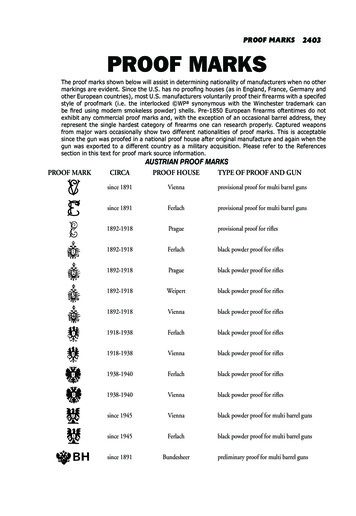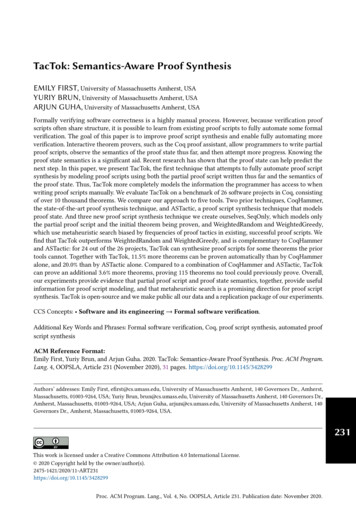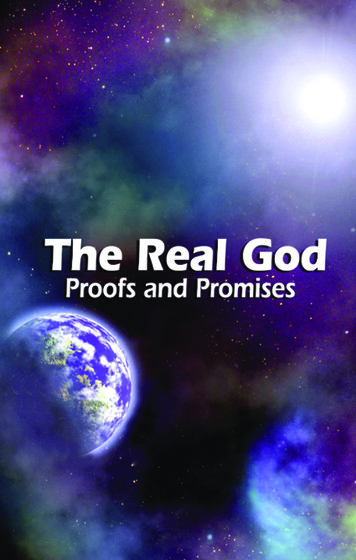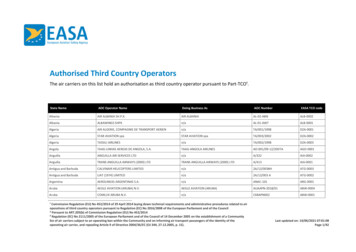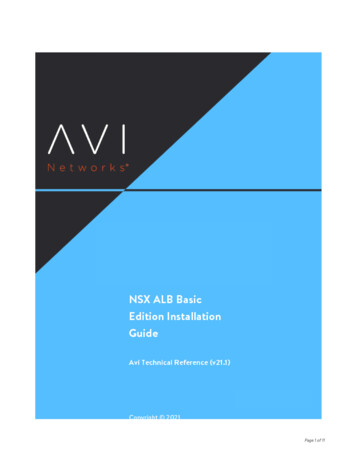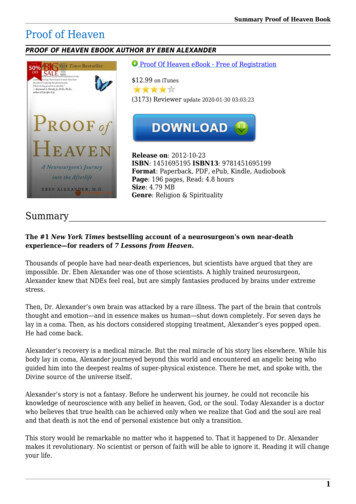
Transcription
ON PROOFTHE ALBÉNIZ CONCERTOA ‘new’ Romantic concertoStephen Goss’s concerto for guitar and orchestra afterthe piano music of Isaac Albéniz (1860-1909)By GUY TRAVISSXUEFEI YANG’S new concerto recording for EMIClassics comprises her much-anticipated version ofRodrigo’s Concierto de Aranjuez and the first recording of a new concerto by Stephen Goss based on themusic of Isaac Albéniz. The CD was recorded inBarcelona in July with Eiji Oue conducting theBarcelona Symphony Orchestra (OrquestraSimfònica de Barcelona i Nacional de Catalunya). Inaddition to the concertos, the CD also features soloworks by Rodrigo and Albéniz. All the music on thealbum resonates closely with Barcelona. TheAranjuez concerto had its first performance there 70years ago, and the city has strong associations withthe life and work of Albéniz.EMI commissioned Stephen Goss’s new concertoto mark the 150th anniversary of Albéniz’s birth.After initial discussions, Goss decided to write a fullblown romantic guitar concerto based on four specific piano pieces – El Albaicín and Evocación fromIberia (1905-07), and Cataluña and Aragón fromSuite Española (Op.47). Each of these pieces hasbeen transformed into a concerto-style movement;the overall movement plan of the concerto attemptsto give the impression of an integrated piece ratherthan a selection of arrangements. The cadenza,placed between the third and fourth movements,uses material from all the movements. The musicallanguage and orchestrational approach of the pieceremain firmly rooted in Albéniz’s stylistic idiom,occasionally making references to the music ofDebussy, Falla and Rodrigo. Goss’s starting pointwas a question: ‘If Albéniz had written a guitar concerto, what would it have been like?’The concerto represents the most recent of five collaborative projects between Yang and Goss (Head ofComposition at the University of Surrey, UK). Threefifths of that history is concerned with Chinesemusic, a theme marked from the very beginning oftheir relationship with Raise the Red Lantern (2004),based on Chinese films, for an album of Chinesebased music on GSP. Composer and performer firstmet on an occasion when guitarist JonathanLeathwood was performing Goss’s Oxen of the Sunin London in 2003, a piece commissioned byLeathwood for ten and six-string guitars playedsimultaneously. At the time Yang was looking tocommission works for herself and recalls being‘attracted to the atmospheric, evocative and delicatesoundscapes painted in Steve’s music.’ Yang subsequently commissioned Goss to write a further threepieces. The Chinese Garden (2007), based onChinese folksongs, was written for Yang’s secondEMI album, 40 Degrees North, and first performed atLondon’s Wigmore Hall. In 2008 Goss made anClassical Guitar MagazineIn studio with Eiji Oue (conductor) andJorn Pedersen (producer).arrangement of Sarasate’s Navarra for two violins(David Garrett and Valeriy Sokolov), guitar (XuefeiYang) and orchestra for the Classical BRIT Awardsat the Royal Albert Hall, which was subsequentlyrecorded on the Best of the Classical BRITs CD. AfterThe Albéniz Concerto was completed in 2009, Yangcommissioned The Autumn Song (2009) for cello andguitar for her concert tours with Natalie Clein. Thisbeautiful but melancholic piece is based on storiesabout the Great Wall of China. The first performancetook place at the Macau Festival in China followedby tours in Europe. All in all, Yang has given around200 performances of Goss’s music since they beganto collaborate in 2004.The collaborative model is intrinsic to Goss’swork as a composer, a creative process we identifywith much of the guitar’s core repertoire from thelast century: ‘The history of the guitar’s twentiethcentury repertoire is a history of collaboration’[Leathwood, p.8.]. The way in which composer andperformer come together to produce just a singlepiece, and very little thereafter, is a consistent feature of many of the past collaborative engagementsLeathwood is referring to. This is understandable,since collaborations are generally the result of commissions which supply funding for a specific project and purpose, and therefore we frequently findone-off works by composers assigned to a particular dedicatee. Collaborators may repeatedly worktogether over a period of many years if opportunities present themselves, although this type of ongoing relationship is perhaps less common. For Goss1
however, collaborating with one performer over thecourse of five pieces is not untypical: ‘Collaborativerelationships are complex and sometimes difficult.When you find someone you can collaborate withwell and the end result is good, then there is a greattemptation to collaborate with that person again.There is a kind of guarantee, youtrust that person. There arepianists, cellists, flautists and guitarists I have done four or five collaborations with. You find yourselfgoing back to the same performers. The next time you work withsomeone it takes the overallprocess further.’ There are manyaspects of the collaborativeprocess that allow the composerto adapt their writing to the performer they are working for.Although the exchanges betweencomposer and performer are oftenmade to address practical matters, such as technical idiosyncrasies, the processhas much more to do with realising the work itselfas a performance item; it’s about composer and performer working towards a version of a work represented on the page. This is the crux of the issuewhere Goss is concerned: ‘If the collaborativeprocess is about anything, it’s about getting to theessence of the music and understanding how itneeds to sound. It’s understanding the music ratherthan understanding the notation. One of the reallygood things about working with Fei is that she really gets what the essence of the music is. I find it particularly gratifying when the performer makes thepiece his or her own. They go off and perform thepiece many times, and eventually it becomes theirpiece rather than mine.’ Goss is used to multipleperformances of his works: David Russell performedEl Llanto de los Suenos (2007) in every one of his solorecitals for a year, Michael Partington has performedhis Sonata (2006) over 70 times and recorded ittwice, and Jonathan Leathwood has performedOxen of the Sun (2003-04) around 100 times. Fromthe performer’s perspective, on the subject of collaboration, Yang gets straight to the heart of the matterwhen she succinctly states: ‘I can’t communicatewith Albéniz, but I can communicate with Steve’.Goss adds: ‘Listening to Fei play Albéniz had a hugeinfluence on the piece, she has recorded his music alot and I have heard her play it in many concertsover the years. My whole approach was very muchcoloured by my imagination of Fei playing Albéniz ina concerto context’. There is clearly an environmentof give and take in their collaborative relationship asYang elucidates: ‘When Steve was writing the concerto, I was encouraged to make many suggestionsand to feedback all my thoughts and ideas. I mightsay “this passage might sound more beautiful upthe octave” or “please can I have this melody insteadof the orchestra getting it” and Steve would (usually)oblige.’Following the critical and commercial success of40 Degrees North in 2008, EMI and Yang began discussing plans for her next recording when the ideaof the concerto disc surfaced: ‘We thought that itwould be great to do the Aranjuez, the obvious firstchoice, but also something new to place alongside it.I thought that Albéniz could workreally well for guitar and orchestra, but then there was the question of who is going to do thearrangement?’ In fact it wasStephen Johns, vice-president ofEMI Classics and the person overseeing her next recording, who putGoss’s name forward based atleast in part on the arrangementsof Chinese folk songs he had previously supplied to Yang amongtheir other work together. InitiallyGoss came up with two ideas; onewas simply to do arrangements ofAlbéniz pieces for guitar andorchestra, and the other was to do a concerto. Yangand others involved were quick to support the notionof an Albéniz concerto: ‘EMI backed the idea of aconcerto and so did I, it seemed more creative and agreat pairing with the Aranjuez.’Fei - “When Stevewas writing theconcerto, I wasencouraged tomake manysuggestions andfeedback allmy thoughtsand ideas”2The concerto repertoire for guitar is comparatively rich, but there is little of note betweenGiuliani’s three concertos of the early 19th century and the Aranjuez concerto composed inIn studio with Jorn Pedersen (producer)and Steve Goss.Classical Guitar Magazine
1939. This commission provided Goss with theperfect opportunity to fill that gap in the repertoire:‘With Albéniz’s music you get that wonderful richlate romantic harmony infused with Spanish folkmusic and French impressionism. There really isn’tanything similar in the concerto repertoire. Thinkingbeyond this collaboration, it was a great opportunity to provide guitarists with a Romantic concerto toplay.’ In a sense, today the conditions are right foran Albéniz guitar concerto, since the formatdemands a level of virtuosity from the soloist thatwould have been difficult for contemporaries ofAlbéniz to meet. Albéniz did however have some ofhis works arranged for guitar in his lifetime, but theidea of the guitar being the instrument it is now withvirtuoso players such as Yang was unknown at thattime. Still, even now we recognise the difficultly ofmastering reworkings of Albéniz’s music: ‘The influence of Andalusian guitars on Albéniz is sufficientlyobvious to invite transcription for guitar. [Manypieces] sound most convincing in transcription, butcall for an advanced technique’ [Robert Spencer,p.429.]. We can easily find a place for a work suchas the Albéniz concerto, but we can also identifyother areas where the guitar concerto repertoire islacking. Goss shares his thoughts on the subject:‘In many ways what the guitar needs now is a bigAmerican concerto by a Steve Reich or a JohnAdams.’The original brief of arranging some of Albeniz’smusic for guitar and orchestra presented Goss withseveral possibilities, all of which resonate stronglywith the composer’s known stylistic diversity andcompositional aesthetic, as Leathwood attests: ‘Withan ambivalent attitude towards notions of author-ship and originality, Steve has made no secret of hisuse of samples and models from other composerspast and present. Sometimes the work of others isechoed in a relatively recognisable form; at othertimes it is apparent only to those in the know,occluded as it is by filters or other distortions in thecompositional process’ [Leathwood, p.14.]. In thisinstance, we can see that Goss has taken up oneextreme of Leathwood’s description, for the resultingwork is based entirely on four of Albeniz’s pianopieces. The use of whole-scale structures in this waycan be found elsewhere in Goss’s work, again something Leathwood identifies when considering hisown collaboration with the composer on Oxen of theSun [Leathwood, p.20.]. We can also find examplesamong his compositions where pre-existing pieceshave been transformed in some way and becomecomponents of new musical structures (for example,The Garden of Cosmic Speculation, 2005, for violin,cello, piano and bass clarinet, The Raw and Cooked,2004, for two guitars, or Portraits and Landscapes,2010, for piano).The music of IsaacAlbéniz often evokes thesound of the guitar; so itcomes as a surprise tomost that he neverwrote a single note forthe instrument. Today,paradoxically, it isthrough the myriad ofguitar transcriptions ofhis piano works thatAlbéniz’s music is mostly widely performed andXuefei Yang insideBarcelona Auditori.Barcelona Auditori, with orchestra, conductor Eiji Oue and composer Steve Goss.Classical Guitar Magazine3
known. Still, it is a point that escapes entries underAlbéniz’s name in Grove and OCM among other keyreference texts, which prefer instead to focus on hisreputation as a pianist during his own lifetime. Thisis not to say these writers disagree with or are otherwise unaware of what has happened to the composer’s music since his death (while not forgettingthat references of this kind predominantly concernthemselves with biographical content), but rather afailure to acknowledge the issue demonstrates thesegregation of solo guitar works from mainstreamcanonic repertoire. Albéniz’s synonymity with theguitar is widely recognised, and it is with thisthought that we can attribute a special significanceto the notion of an Albéniz guitarconcerto; a work for guitar andorchestra with greater potentialfor showcasing to a more pervasive audience that Albéniz’s catalogue is increasingly subsumedunder titles featuring guitar.these arrangements of Albéniz’s music were notintended to mislead listeners from the very beginning, rather we understand them as such todaybecause they have come down to us divorced fromtheir intended instrument. So to give the concertooriginal status from the very beginning, as opposedto gradually acquiring this identity over time, is toraise compositional considerations from the outset:‘It’s funny, I often wonder what Albéniz would thinkof the fact that so many guitarists play all his pianomusic now, or that his music is performed widely atall. And what would he think about a concerto? Thedanger for me, of course, was to imagine myself asan equal partner with Albéniz instead of remainingaservanttohismusic.Consequently, I tried to writemyself out of the concerto so thatpeople can go and hear it andbelieve that it could have beenwritten by Albéniz. There is nothing in the orchestration or the harmony that couldn’t have beendone in Albéniz’s time.’Steve - “I tried towrite myself outof the concerto sothat people mightbelieve that itcould have beenwritten byAlbeniz”Having decided on a genre as ameans to rework a selection ofAlbéniz pieces, for Goss the central issue then became anotherquestion: ‘How can I turnAlbéniz’s piano music into something which sounds as if it has always been a guitarconcerto?’ A forgery passed off as the genuine article? More of a fabrication than, say, Deryck Cooke’sMahler 10 or Anthony Payne’s Elgar 3 completions:Albéniz didn’t leave an incomplete guitar concerto inthe way that Mahler and Elgar left incomplete symphonies.This idea has a complementary basis, as thosewho experience Albéniz through the guitar rarelysuspect the music’s piano origin. Because of this,there already exists a model for Albéniz forgeries forGoss to capitalise on: ‘People imagine Albéniz as aguitar composer, so the idea of an Albéniz guitarconcerto is one that an audience can take on board’.Presenting the concerto in the guise of an originalAlbéniz work is something Goss further describes as‘a natural extension of the counterfeit solo guitarpieces that form a major part of the repertoire.’ ButSteve Goss and Xuefei Yang.4Albéniz and the guitar is oneissue, but orchestrations ofAlbéniz form another: ‘What’sinteresting about Albéniz’s musicis that some of the best orchestrations of his musicwere done by other people and not by Albéniz himself’ [Goss]. Albéniz’s great achievement is thetwelve-movement piano suite Iberia (1905-07), perhaps best known today in its orchestral arrangement by Enrique Fernández Arbós – conductor ofthe Madrid Symphony Orchestra and contemporaryof Albéniz. Arbós’s arrangement does not include aguitar, and versions featuring the guitar would notappear until the early 1990s when guitarist-composer Leo Brouwer orchestrated three movementsfor Julian Bream and Steve Gray made three otherarrangements for John Williams’ Iberia CD releasedin 1992. Brouwer’s Iberia Suite (1993) was one ofseveral references for Goss to consider: ‘Brouwer’sorchestrations of Albéniz are as much aboutBrouwer as they are about Albéniz; he shows usAlbéniz’s world through a Brouwer prism. It’s fantastic, but that is not what I am trying to do. WhatTony Payne did when he completed Elgar’s ThirdSymphony was extraordinary; it sounds like Elgarhad finished the piece himself, you can’t hear thejoins. That was my model, a more archaeologicalapproach’. Various orchestrations of Albéniz’s musichave existed since the time of the composer himself,it’s a concept Albéniz and his contemporaries wouldhave been used to, as Dussel notes in his commentson a selection of Albéniz arrangements: ‘In all thesecases arrangements for other instruments or groupsof instruments – arrangements made by the composer himself or by various different arrangers in thecourse of the decades – were the rule rather than theexception. The consequence of this variety is anastonishing colourfulness of instrumentation’[Dussel, p.2.]. At times these new instrumentalClassical Guitar Magazine
forms extend beyond arrangements and transcriptions into what we might consider recompositions, aline that when crossed often catalyses debate forartistic integrity: ‘People who know Albéniz’s musicwell may be surprised to hear what I’ve done with it,my versions might irritate people, they might evenoffend people when they hear some of the liberties Ihave taken.’ How we respond to these matters is ofcourse entirely dependent on our own musical aesthetic, but it’s a point on which Goss takes a firmposition: ‘For most of the second half of the 20thcentury, there was a culture of treating a score morelike scripture than music, almost as if it was a holyrelic: the notion of trying to recreate things exactlyas they once were or were intended to be. Okay, ifyou go and see an actual relic, such as a painting ora sculpture, and you were to touch them then youmight cause permanent damage,but that is a very different thingfrom making changes to a piece ofmusic, or reinterpreting a play. Inother arts (dance, theatre and cinema in particular) radical reinterpretations and reworkings are thenorm: think of Baz Luhrmanns’sRomeo and Juliet or MatthewBourne’s Swan Lake. Music is gradually catchingup with this approach, Uri Caine’s reworkings ofMahler, Beethoven, Schumann and Wagner springto mind as an example, but there are countless others. Many of today’s most prominent composers,such as Thomas Adèsor Wolfgang Rihm,draw on old music asa starting point fortheir work. We live inan age that hasrecycling and conservation at itscore; it’s unsurprising, therefore, that thiszeitgeist is reflected inthe arts.’The choice of Albéniz pieces to use for the concerto was crucial. This meant an arduous task forGoss as he would need to review and processAlbéniz’s entire musical output,ranging from the popular salonpieces of the 1880s to the highlyromantic, almost impressionisticmusic that he wrote in the last fewyears of his life. ‘Steve was keen tomake sure he arranged pieces thatI loved to listen to’, chips in Yang,‘we decided very early on that wehad to have something from Iberia, as it is a workthat means a great deal to both of us’. Of course themost pressing issue was to work out from the piecesthat had been shortlisted which would actually sittogether as a concerto: ‘I was searching for pieces“Quotations meanvery little whentaken out ofcontext”ADVERTClassical Guitar Magazine5
which had thematic similarities, in order for themovements to appear interconnected; also, a balance of keys, a balance of ideas, a balance of weightwith lightness, fireworks with emotion, and so on. Iwanted to have the widest possible gamut of characters, moods and tempi.’ And it was by this processthat Goss was able to discern some complementingfactors in Albéniz’s music: ‘The principal reason forchoosing Aragón as the finale was that its maintheme is very close in contour and character tothemes in two of the other movements (El Albaicínand Evocación).’ To fully integrate the components ofthe concerto, there is a cadenza. Here, all the movements appear cross-related and interrelated to bringeverything together. It is within the cadenza thatthemes from all the movements are mixed up to suggest that they have always belonged together as partof the same composition. Illusion and artifice itmight be, but The Albéniz Concerto is a very satisfying and convincing listen. Perhaps the last wordshould go to Professor Walter Aaron Clark, author ofthe definitive biography of Albéniz in English, IsaacAlbéniz: Portrait of a Romantic (1999, OUP).‘[Goss’s] idea to recast these numbers as a guitarconcerto is brilliant, both in conception and execution. I think he has captured the spirit and essenceof the works and given us new perspectives onthem. Goss has done something wonderful forAlbéniz’s music with this remarkable concerto.’HOUSE ADThe Albéniz Concerto was first performed by theRoyal Liverpool Philharmonic Orchestra on 24October 2009 at the Philharmonic Hall, Liverpool.The conductor was Shi-Yeon Sung and XuefeiYang was the soloist. The next performance is inDublin on 7 January 2011 when Xuefei will bejoined by the RTÉ National Symphony Orchestra.The EMI recording of The Albéniz Concerto wasreleased on 1 November. The score, guitar partand piano reduction are published by CadenzaMusic.Further details can be found lassics.comhttps://cadenza-music.comCollaborations betweenStephen Goss and Xuefei YangRaise the Red Lantern (2004) for guitar (16 mins)Commissioned by Xuefei Yang and GSP Records SanFrancisco. First performance 19 April 2004, WigmoreHall, London. Recorded by Xuefei Yang on Si Ji(GSP1028CD 2005). Published by Cadenza Music 2004The Chinese Garden (2007) for guitar (12 mins)Commissioned by Xuefei Yang for China Now 2008.First performance 16 April 2008, Wigmore Hall,London. Recorded on 40 Degrees North, EMI Classics(5099920632229 2008). This CD won BestInstrumental Album in the 2008 Canton RadioAwards in China. Published by Cadenza Music 2008Navarra (arr. Goss 2008) for two violins, guitar andorchestra (4 mins)Commissioned by EMI for the Classical BRIT Awards.First performance 8 May 2008, Royal Albert Hall,London. First broadcast performance 15 May 2008,ITV1. David Garrett and Valeriy Sokolov - violins,Xuefei Yang - guitar, David Charles Abell – conductor,London Concert Orchestra. Recorded on The Best ofthe CLASSICAL BRITs, Various Artists, The BRIT Trust(MOS2009TMS1 2009)The Albéniz Concerto (2009) for guitar and orchestra(28 mins)Commissioned by EMI Classics for Xuefei Yang andthe Barcelona Symphony Orchestra. First UK performance 24 October 2009. Shi-Yeon Sung - conductor,Xuefei Yang - guitar, Royal Liverpool PhilharmonicOrchestraThe Autumn Song (2009) for cello and guitar (7 mins)Commissioned by Natalie Clein and Xuefei Yang fortheir concert tours in 2009 and 2010. First performance 13 October 2009, Macau Festival, Macau,China. UK premiere 3 February 2010, Wigmore Hall,LondonReferencesDussel, K., (Translation: Diana Laos): Salon OrchestraFavourites Vol. 1 (Catalogue No.: 8.554756) accessed26/4/2010, p.2Grove Online: Albeniz, accessed 24/4/2010Clark, W. A., in Latham, A., 2002: Oxford Companionto Music (Oxford University Press, New York) pgs.20 &21.Leathwood, J., 2009: The Anxiety of the Dedicatee,Two Studies in Composer-Performer Collaboration(University of Surrey) pgs.8, 14 & 20.Spencer, R., 1963: Musical Times, Spanish GuitarMusic (Vol. 104, No. 1444) p.429.6Classical Guitar Magazine
Classical Guitar Magazine 3 1939. This commission provided Goss with the perfect opportunity to fill that gap in the repertoire: 'With Albéniz's music you get that wonderful rich late romantic harmony infused with Spanish folk music and French impressionism. There really isn't anything similar in the concerto repertoire. Thinking


